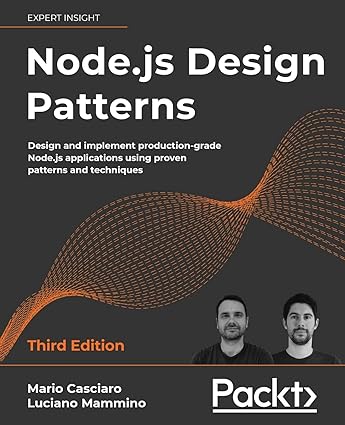White Paper: Leveraging Node.js Design Patterns for Robust and Scalable Applications
Abstract
Node.js has emerged as a powerful and versatile platform for building scalable and high-performance web applications. However, as the complexity of Node.js applications grows, so does the need for well-structured and maintainable code. Design patterns provide proven solutions to common software design problems and can significantly improve the quality and efficiency of Node.js applications. This white paper explores key Node.js design patterns, drawing insights from the renowned book "Node.js Design Patterns: Design and Implement Production-Grade Node.js Applications Using Proven Patterns and Techniques"
Introduction
Node.js, with its asynchronous, event-driven architecture, offers a unique approach to web development. However, without careful design considerations, Node.js applications can become complex and difficult to manage. Design patterns provide a blueprint for solving common design challenges, promoting code reusability, and improving overall application performance and maintainability.
Key Node.js Design Patterns
- Event-Driven Architecture:
- Core to Node.js: Event-driven architecture is fundamental to Node.js, enabling efficient handling of multiple concurrent requests without blocking the main thread.
- Pattern Implementation: Utilize Node.js's built-in event emitter module to create custom event-driven systems, decoupling components and promoting asynchronous operations.
- Asynchronous Programming:
- Non-Blocking Operations: Employ asynchronous programming techniques like callbacks, promises, and async/await to avoid blocking the event loop and maintain high performance.
- Pattern Implementation: Leverage Node.js's built-in modules like fs, http, and net to perform asynchronous file operations, network requests, and other I/O-bound tasks.
- Middleware Pattern:
- Modularizing Request Handling: Create reusable middleware functions to handle common tasks like logging, authentication, and error handling.
- Pattern Implementation: Use Express.js middleware to intercept requests and modify responses before they reach the final handler.
- Repository Pattern:
- Data Abstraction: Encapsulate data access logic in a repository layer to separate concerns and improve code maintainability.
- Pattern Implementation: Use Object-Relational Mappers (ORMs) like Sequelize or Mongoose to interact with databases and provide a clean API for data operations.
- Service Locator Pattern:
- Centralized Dependency Injection: Use a service locator to manage and provide access to shared services and dependencies.
- Pattern Implementation: Implement a service locator class or module to register and retrieve services, promoting loose coupling and testability.
- Command Query Responsibility Segregation (CQRS):
- Separating Read and Write Operations: Separate read and write operations into distinct models and services to improve performance and scalability.
- Pattern Implementation: Use different data stores for read and write operations, such as a relational database for writes and a NoSQL database for reads.
- Event Sourcing:
- Persisting State Changes: Store a sequence of events representing the state of an application, providing a complete audit trail and enabling time travel debugging.
- Pattern Implementation: Use event sourcing frameworks like EventStoreDB or Kafka to capture and store events, and implement event handlers to reconstruct the current state.
Best Practices for Effective Node.js Design
- Prioritize Asynchronous Operations: Avoid blocking operations to maintain high performance and responsiveness.
- Embrace Modular Design: Break down your application into smaller, well-defined modules to improve code organization and maintainability.
- Use a Consistent Coding Style: Adhere to a consistent coding style and use a linter to enforce code quality standards.
- Write Thorough Tests: Implement unit, integration, and end-to-end tests to ensure code quality and prevent regressions.
- Monitor and Optimize Performance: Use profiling tools to identify performance bottlenecks and optimize your application.
Conclusion
By understanding and applying Node.js design patterns, developers can build robust, scalable, and maintainable applications. By following best practices and leveraging the power of design patterns, engineers can create efficient and effective Node.js solutions that meet the demands of modern web development.
References
- Osmani, A. (2017). Node.js Design Patterns: Design and Implement Production-Grade
- Node.js Official Documentation: https://expressjs.com/
- Sequelize ORM: https://mongoosejs.com/
- EventStoreDB: https://kafka.apache.org/
By incorporating these design patterns and best practices, you can elevate your Node.js development skills and create exceptional web applications.



